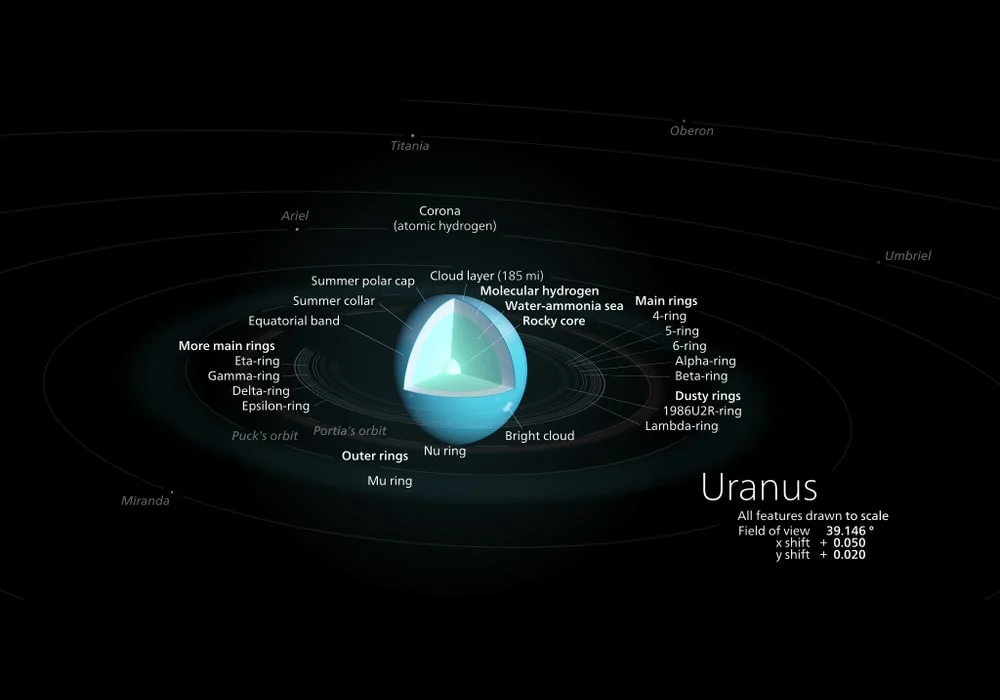Planet Uranus
Uranus is the seventh planet in the Solar System in order of distance from the Sun. It orbits around it at a distance of about 19.2 astronomical units (2.87 billion kilometers), with a period of revolution of 84.05 Earth years. It is the fourth most massive planet in the Solar System and the third largest in size.
It is the first planet discovered in modern times with a telescope and not known since ancient times. Although it is visible to the naked eye, its planetary character is then not identified due to its very low brightness and its apparent movement in the sky very slow. William Herschel observed it for the first time on March 13, 1781 and the confirmation that it was a planet and not a comet was made during the following months.
Like Jupiter and Saturn, Uranus’ atmosphere is composed mainly of hydrogen and helium with traces of hydrocarbons. However, like Neptune, it contains a higher proportion of “ice” in the physical sense, that is to say volatile substances such as water, ammonia and methane, while the interior of the planet is mainly composed of ice and rocks, hence their name “ice giants”. In addition, methane is the main responsible for the aquamarine hue of the planet. Its planetary atmosphere is the coldest in the Solar System, with a minimum temperature of 49 K (−224 ° C) at the tropopause, and exhibits a cloudy layered structure.
Like the other giant planets, Uranus has a ring system and many natural satellites: it is known to have 13 narrow rings and 27 moons. It is unique in the Solar System in the sense that its axis of rotation is practically in its plane of revolution around the Sun – giving the impression that it “rolls” in its orbit, at least at a certain moment of its revolution – and its North and South poles are therefore found where most of the other planets have their equator. The planet is provided with a magnetosphere in the shape of a corkscrew due to this inclination of the axis.
The distance of the planet from the Earth giving it a very small apparent size, its study is difficult with telescopes located on the Earth. Uranus is visited only once during the Voyager 2 mission, which overflows it on January 24, 1986. The images from the space probe then show a planet almost without relief in visible light, without the bands of clouds or storms. associated with other giant planets. The advent of the Hubble Space Telescope and large adaptive-optic ground-based telescopes then allows for additional detailed observations revealing seasonal change, increased weather activity, and winds of around 250 m / s as Uranus approaches. of its equinox in 2007.
Its name comes from Ouranos, Greek deity of the sky (Uranus in Roman mythology), father of Cronos (Saturn) and grandfather of Zeus (Jupiter).
Place in the solar system: 7th planet
Size: 50,724 km in diameter (3rd largest planet)
Weight: 8.681 0 × 1025 kg
Distance to the sun: 3 billion km
Maximum distance from Earth: 3,157 million km
Temperature: −225 ° C
1 day on Uranus: 5 p.m.
A year on Uranus: 84 years
Surface: gas, molten rocks and ice
Atmosphere
| Atmosphere | |
|---|---|
Scale height | 27.7 km |
| Composition by volume | (Below 1.3 bar) Gases:
Ices:
|
A bit of history, Uranus is playing hide and seek with us
In the Zodiac, Uranus is the planet of Aquarius. First strangeness, because Uranus was not known to the ancients. He may have been the star described by Hipparchus in 128 BC. AD, in what is reported by Ptolemy, but this is only a conjecture.
After the Renaissance, astronomers will take Uranus for a long time for a star, like 34 Tauri mentioned by Flamsteed in 1690. It must be said that its apparent extremely slow movement in the sky is misleading. William Herschel first described the planet using a telescope in 1781. Friend Aquarius, you haven’t had your planet since the dawn of time, but astrologers quickly recovered it!
Tools with the help of scientists
The discovery of Uranus is one of those beautiful scientific anecdotes. Herschel was looking for double stars, and it was by chance that he saw a small intriguing spot. The size of the spot changes with the eyepiece of the telescope, unlike stars that are too far away. A comet, no doubt.
At the time, we only knew the paradigm of the five planets, not counting the Earth of course. But returning to it after a few days, the behavior is different from that of a comet: it is the stir among scientists of the time. Lexell estimates its distance from earth, Bode is the first to notice the planetary character of the orbit, which he thinks is around Jupiter, but Lexell will manage to match the observations with a true planetary model. End of the paradigm of the five planets!
Today, scientists are looking for a possible ninth planet suggested by small alterations in the models: Uranus was the first to be confirmed by scientific deductions. Thanks to his observation, we will later deduce the presence of the invisible Neptune.
Crescent end of Uranus
After having almost been called George, then Neptune, political names to the glory of the king and the navy of England, the planet will be called Uranus by an unstoppable logic: Saturn being the father of Jupiter, it could only take the name of the father of Saturn. Uranus originated in our consciousness, but still remains as mysterious as ever.
Today we are used to a lot of exploits, to all kinds of images of space. And yet, for two centuries there will be hardly any meaningful discovery about Uranus which is too far away from us. It is only from the middle of the twentieth century that new means will finally begin to lift the veil on this strange planet which deserves to be known.
The discreet theater of its moons and its rings
From Earth, we will first discover five moons, which are agglomerates of rock and ice, and then, again by chance, five very dark rings. Uranus therefore also has its rings, less spectacular than those of Saturn. Four more will be identified shortly after. It is the second ring system discovered in our solar system.
Its largest moon, Titania, is the eighth in size in the solar system. The names of the satellites of Uranus come from the plays of the English theater, honor to its discoverer.
An unprecedented, very particular and still unexplained inclination
Physicists and astronomers had also noticed a peculiarity of Uranus: it is the only planet that turns lying down! To be more precise, its own axis of revolution is almost parallel to its orbital plane, and therefore Uranus has its poles where the others have their equator. It is often said “that it rolls in its orbit”.
It is entrusted to the Voyager 2 probe, during its long journey, the role of giving indications on this atypical phenomenon. It is the first probe to pass near Uranus. In reality, the main objective was to give it the acceleration to keep going. She will “see” ten satellites and two more rings than those already spotted, and will notice that the rings are recent and formed of debris.
Voyager 2 will leave us with pictures of an electric blue calm, the only ones taken so close. The other photos will come mainly from another technical feat: Hubble, the famous space telescope.
At the heart, a permanent source of questions
Since January 24, 1986 when Voyager 2 passes too fleetingly near Uranus, ground telescopes, then Hubble, have taken over to unravel its mysteries. To date, there are thirteen rings and 27 satellites. Large spots would suggest colossal storms. Hubble also provides some very nice pictures of the polar lights.
So it’s time to talk about the makeup of the planet. Uranus has, like Neptune, a mass and an intermediate density between the tellurics and the gas giants: fourteen times the mass of the Earth, for a radius four times greater. Associated first with the gas giants that precede it, it is now classified as a cold Neptune type, an icy giant far from its star.
Its internal composition would be fairly uniform, consisting of molten ice and rock, with a solid core shape. Around this controversial core, we imagine the mantle as a sort of ocean of ammonia and methane.
All this at very low temperatures: Uranus would be the coldest planet in the solar system, with a record of 49 ° K (-225 ° C). A curious ocean of improbable metallic carbon on which diamonds would float!
An exceptionally long midnight sun for an unstable climate
Could the atmosphere on Uranus be more conventional? Perhaps, because formed from hydrogen and helium in standard so-called solar proportions. However, with a lot of water, ammonia and methane giving it its cyan color, and a fuzzy border with the surface ocean.
And the seasons are strange there: remember this atypical inclination of its equator on the ecliptic, nearly 98 °, almost on the disk of revolution. Its duration of revolution being 84 years, each pole is therefore successively exposed to the Sun for 42 years! This very slow exposure seemed to explain an apparently calm atmosphere.
Since then, there have been significant movements. The winds are said to be violent, up to 900 km / h. While the inner layers rotate 17 h 14 min, some layers of the atmosphere rotate in less than 14 h, causing eddies at altitude.
Two last oddities, before others certainly
Its energy emission is barely greater than that it receives, yet 900 times lower than on Earth given its average distance of three billion km from the sun. In short, Uranus has almost no internal heat. No need to consider geothermal energy to warm up!
As with Neptune, the other ice giant, Uranus’s magnetic field is very asymmetric, eleven times stronger at the North Pole than at the South Pole. Perhaps because it would be generated by an intermediate layer rather than the core.
Its inclination of 60 °, detected by Voyager 2, is on the other hand a unique specificity. What still does Uranus have in store for us? A closer look is not for tomorrow. If its orbit is almost circular, Uranus is at best two and a half billion km from Earth. Unfortunately, there is no specific program planned to explore Uranus, since the abandonment of the passage through Cassini after his departure from Saturn. Uranus will long remain a mine of mysteries.
Uranus rules Aquarius
Uranus reminds us that life is always on the move, that pitfalls can arise at any time. But it is also the announcement of positive changes, of choices to be made at every crossroads of existence. Its presence can therefore be synonymous with creation as well as destruction. This planet can also represent iconoclastic, singular personalities, eager for freedom. It can announce some anger. Earth is the associated element.
When the presence of Uranus is positive it illustrates an independent character, free, showing originality. It also announces sudden and joyful events.
When its presence is negative, it warns against selfishness, a risk of marginality. This planet also refers to the addicts of life, to difficult events.
Uranus is the planet of Aquarius, thus recalling the adventurous, even rebellious side of these people, their need for freedom, their individualism but also their instability.
Sources: PinterPandai, NASA Science, Space Facts, The Planets
Photo credit: Wikimedia Commons



